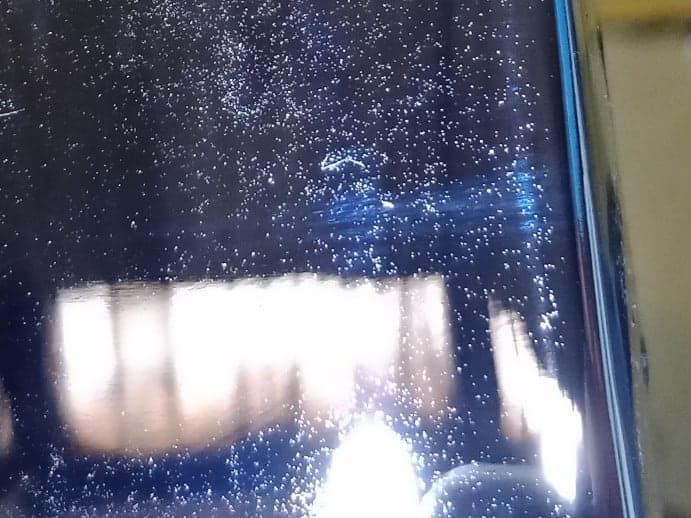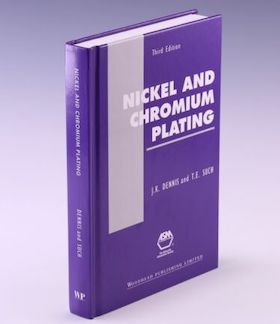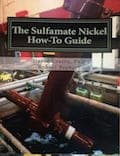
Curated with aloha by
Ted Mooney, P.E. RET

The authoritative public forum
for Metal Finishing 1989-2025

-----
Function of Boric acid in Nickel Plating
Q. In the Ni deposition, even after adding Boric Acid, to control pH we add a base, possibly NaOH. I would like to know if the effect of Boric acid will be nullified with the addition of NaOH.
Aashish John- Bournemouth, Egland
April 27, 2022
A. Hi Aashish. Boric acid is a buffer, or pH stabilizer, or dampener. But you can certainly overcome it and raise the pH by adding NaOH.
Reading between the lines, though, you might find thread 23867 interesting because normally the pH of a nickel plating bath rises in operation, calling for acid additions, it doesn't drop and need NaOH or nickel carbonate. If it is dropping, you might want to double check that you are using the correct sulfurized-nickel anodes, not pure nickel anodes, and that your anode bags are not badly clogged.
Luck & Regards,

Ted Mooney, P.E. RET
Striving to live Aloha
finishing.com - Pine Beach, New Jersey
April 2022
A. Hello, Aashish,
It is said that the boric acid acts as a buffer, but actually its pKa is 9.24, which means it acts as a buffer around pH 9.
Some authors say that the real function of boric acid is to complex the nickel ions.
As an acid, it surely helps control the pH, but it is common to regulate it with additions of diluted sulfuric acid or sodium hydroxide, I believe there's no need to be worried.
Regards,
Chemical Engineer - Nova Friburgo, Rio de Janeiro, Brazil
April 28, 2022
A. We do not want sodium in a nickel plating solution (sulphate nor sulfamate). Do not add NaOH, raise the pH with Nickel Carbonate.

Robert H Probert
Robert H Probert Technical Services
Garner, North Carolina

April 29, 2022
⇩ Related postings, oldest first ⇩
Q. Could anyone please advise me of the function that Boric Acid plays in Nickel Plating? Does it act as a buffer for pH control?
Andrew Elliott- Sheffield, UK
2001
A. Yup. A portion of the water in the solution hydrolizes as H2 gas and 2OH-. The H2 evolves as a gas, leaving the 2OH- behind to try to
lower ^
raise the pH from where you wanted to hold it.

Ted Mooney, P.E.
Striving to live Aloha
finishing.com - Pine Beach, New Jersey
2001
2001
A. Ted and I rarely disagree, but he had an "OOPS" here. The remaining OH, as stated, is a hydroxyl group and would actually raise the pH.
Boric acid, H3BO3, has the capability of ionizing with an H+ and a H2BO3- which provides one hydrogen ion to react with an available OH-. Actually, you can titrate a saturated boric acid solution with 0.1N NaOH
⇦ this on
eBay or
Amazon [affil links]
and done carefully, find three separate pH's that it will try to hold.
The purpose of all this is: hydrogen forms nascent hydrogen, H2, at the surface of the plated part, leaving a two free OH- groups which raises the pH at the surface of the part and a couple of millionths of the solution (which is the diffusion or barrier layer). This higher pH typically forms a black deposit or at least, a nasty one. The H+ from the boric acid reacts with the OH- to hold the pH stable.
The beauty of a buffer is it is bi directional, resisting movement in either direction, thus it takes an available hydrogen and goes back to the original ion. This is why agitation is so important in most baths and you have to add acid to a nickel tank.
Drag out is by far the biggest loss of boric from a tank. Actual use or destruction is very minimal.
This is also why it is so hard to change a pH on a tank. You add and add and very little happens and then it abruptly changes a huge amount.
It is much more complicated, but that is the short version of it.
- Navarre, Florida
![]() Indeed it was an "oops". The OH- is left behind as I said, but this does indeed raise the pH, not lower it. Thanks for your far more detailed explanation as well, Jim.
Indeed it was an "oops". The OH- is left behind as I said, but this does indeed raise the pH, not lower it. Thanks for your far more detailed explanation as well, Jim.

Ted Mooney, P.E.
Striving to live Aloha
finishing.com - Pine Beach, New Jersey
2001
Multiple threads merged: please forgive chronology errors and repetition 🙂
Q. Why do we add boric acid in watt's solution? It it to control rate of deposition? If that's the case will boric acid control rate of deposition in say copper sulphate ⇦ this on eBay or Amazon [affil links] solution?
Ravi SHankarPurdue University - West Lafayette, Indiana, USA
2002
A. Boric acid is added to lots of nickel plating solutions, and indeed many others, to act as a pH buffer. When metal is electrodeposited onto a cathode, the pH in the immediate vicinity of the cathode increases to very high levels. It can reach up to pH 11 or 12 very near to the surface of the electrode. The higher the cathodic current density, the higher the pH will rise. However, at pHs above about 6, nickel is precipitated as nickel hydroxide and if this happens at the cathode surface, the deposit will look very dark and is known as "burnt". To overcome this, boric acid is added to the bath as this controls and reduces the changes in pH, thus preventing the precipitation of hydroxides. However, boric acid is only useful at pHs above about 4, so where it is of little use in very acidic solutions such as acid copper. You can, in theory, run a nickel bath at very low pH's, but at these low pH's the efficiency will fall off dramatically as you will co-deposit hydrogen;! this will also lead to hydrogen entrapment and subsequent embrittlement of the deposit. In many applications, such as aerospace, this would be a total no-no.
Most nickel baths use between 30 and 40 g/l of boric acid; personally I like to run at levels closer to 40 than 30 as I have found it keeps the bath in better control. As a side issue, I have come across one well known company who operates a nickel electroforming bath at 120g/l boric acid, but they operated a sulphamate nickel bath at 90C. What I did find surprising about their bath was it didn't suffer from any stress or apparent breakdown of sulphamate to ammonia
⇦ this on
eBay or
Amazon [affil links] and sulphate. Their "trick" was to regularly replace some of the electrolyte and always keep it hot - if they didn't, the pipes got clogged with boric acid crystals and once this happens it is a real pig trying to redissolve it!
For many years there has been some conjecture as to whether boric acid is co-deposited with the nickel; some sophisticated analytical techniques have shown traces of boron in nickel deposits, but the levels are so low as to be of no importance.
In summary, boric acid is added to help keep the nickel in solution and to improve the quality of the deposit as well as increase the operating range of the electrolyte.

Trevor Crichton
R&D practical scientist
Chesham, Bucks, UK
2002
My nickel bath has crystals, what can I do to liquify/dissolve them?
Q. I work in a small PCB house and we have a nickel bath to plate edge connectors. Sometimes it gets a lot of use and other times it just sits idle. We have a problem with crystal formation which occupies quite a bit of our bath. We would like to "de-crystallize" the nickel and continue to use it, is this possible? What techniques can we use to liquefy these nickel crystals and incorporate the nickel back into our plating process?
Cliff Heckenberg- Ohio,USA
2005
A. Recrystallization comes from loss of water and consequent cooling. Add the required amount of water to restore original level, a little heat and patience. No big deal. Then analyze chemistry.
Guillermo MarrufoMonterrey, NL, Mexico
2005
|
A. The crystals are probably boric acid, if I had to guess. When you aren't using the tank are you letting it cool down? My nickel tanks run boric acid at close to the solubility limit so the boric can crystalize out at lower temps. You will probably cause roughness if you add them directly to the tank. Put the crystals in an anode bag and drape the bag over the side of the tank when it is at temperature.  Trent Kaufman electroplater - Galva, Illinois 2005 A. By "liquify" I presume you mean dissolve. I also assume the bath only shows these crystals when it has been idle and allowed to go cold. The best thing to do is to make the bath up to its correct volume (specification) and then turn on the heaters. If there are a lot of crystals around the heater, you may want to turn the pumps on first and allow them to start to dissolve, otherwise you may burn them out. Analyse the bath to make sure its in spec before you use it.  Trevor Crichton R&D practical scientist Chesham, Bucks, UK 2005 |
A. Probably what you've got is boric acid precipitating out; many nickel baths run with the boric acid concentration close to saturation. As a rule, heating the bath with agitation will redissolve the crystals. I used to run into this with a tab plater; the crystals would plug the sparger holes in the plating cell.

James Totter, CEF
- Tallahassee, Florida
2005
A. What kind of nickel plating solution is it? Is it Sulfamate?
If sulfamate and it has been heated or run at too high anode current density then you have broken down the SN radical into ammonia and sulphate. Go get an ammonia analysis because you may have to dump the bath. Let us know the ammonia content.
If it is simply Boric Acid in a sulfamate bath, you must know that the solubility is limited by the operating temperature. If it does not dissolve at your operating temperature, then you have too much, get it out, filter it out.
The old timers used to say to hang a bag of boric acid in the corner of the tank. That is OK for a sulphate solution. That is not OK for a sulfamate solution. Over the weekend it cools and falls out. On Monday morning the lab tech titrates and adds more boric acid but it will not go in.
Come back with some more information.

Robert H Probert
Robert H Probert Technical Services
Garner, North Carolina

2005
Q. Hi! We are running Ni baths using Ni sulphate solution; and white precipitate forms above the anodes and anode basket readily than those baths using Ni sulfamate. Is this really normal? How do we minimize or eliminate the formation of precipitate? Our preventive countermeasure is to check the baths every day and remove the precipitate manually
Kim Bernat- Laguna, Philippines
August 5, 2018
A. Hi Kim. Yes, this is almost surely boric acid. Please double check what concentration you are trying to hold, and the temperature of the bath. You asked the same question two weeks ago as topic 11706 and Robert Probert answered it the same way. Good luck!
Regards,

Ted Mooney, P.E. RET
Striving to live Aloha
finishing.com - Pine Beach, New Jersey
August 2018
May 12, 2019
Q. I have faced very fine roughness of whitish color only on the stay. This does not seem like roughness due to sand or dust, and only on stay. Filtration is good, no organic impurities as I perform carbon treatment
I plate on sanitary fittings. For two or three days we face a problem you can see in the pictures, only on stay...



Boric is 56 g/l
Nickel is 78 g/l
If this is due to high boric then please tell me how to reduce it.
- Gujranwala, Punjab , Pakistan
A. Hi Bilal. I don't know what you mean by "only on stay"; sorry, but the word 'stay' doesn't mean anything to me in this context.
It is difficult to be sure based on little data (plus your concentrations don't sound right), but it does look like excessive boric acid. Lower the temperature by 15-20 °C and filter the bath. When you reheat it, increasing the solubility, the problem should be gone. Good luck.
Regards,

Ted Mooney, P.E. RET
Striving to live Aloha
finishing.com - Pine Beach, New Jersey
May 2019
⇦ Tip: Readers want to learn from Your Situation
many readers skip abstract questions.
by William Safranek

on eBay or
AbeBooks
or Amazon
(affil links)
Q. Does boric acid work as a hardener in rotary nickel screen?
Shubham patel- AHMEDABAD, India
November 25, 2021
A. Hi Shubham. No it doesn't. Safranek has a 13-page chapter on what factors influence the hardness of nickel deposits, but I see no indication that boric acid content is among them.
Luck & Regards,

Ted Mooney, P.E. RET
Striving to live Aloha
finishing.com - Pine Beach, New Jersey
November 2021
A. Hi Shubham,
Chloride has the biggest effect on Nickel hardness.
This has been my experience with a nickel sulphamate bath.
A chloride content below 8g/l keeps the hardness below 300HV, assuming that low hardness is what you are looking for.
Add more chloride if you want a harder nickel deposit.
Good luck
- A foresaken rock in the irish Sea
November 30, 2021
Q. No, I want to decrease hardness and increase softness in rotary nickel screen. So what is the solution to increase softness in nickel screen.
What is the solution for decreasing hardness of rotary nickel screen? And who was that decrease.
Shubham patel [returning]
- AHMEDABAD, India
December 2, 2021
A. Hi again. From a very quick scan of Safranek (which references 233 other papers and works on the subject), it appears that all addition agents increase hardness, and all metallic impurities (with the possible exception of manganese at certain concentrations) increase the hardness. So the purest possible nickel is probably the softest.
Crotty & Probert generalizes that for sulphamate nickel plating higher current density and lower pH make softer deposits. But your question remains totally abstract :-(
You have not told us what solution you are using -- nickel sulphamate? Nor do we know any operating conditions at all, nor the hardness you want, nor the hardness you are getting, nor what actual problem you are experiencing that you are trying to solve. From a really quick scan of sales literature on rotary nickel screens, most suppliers seem to be proud of their hardness, not their softness ... which brings me to the question of whether you are certain that your problem is excessive hardness rather than excessive internal stress?
Luck & Regards,

Ted Mooney, P.E. RET
Striving to live Aloha
finishing.com - Pine Beach, New Jersey
December 2021
A. He is confused, chloride increase "stress" which he may be calling hardness. Marti and Lanza's paper, "Hardness of sulfamate Nickel Deposits", republished in The Sulfamate Nickel How-To Guide,"in general decrease in deposit hardness with increasing concentrations of bromide or chloride", see the Figure 9. the most effect on hardness is the plating solution temperature, Figure 5 shows that 100 °F is the softest. Other parameters are studied in the same paper, but none are as significant as temperature.

Robert H Probert
Robert H Probert Technical Services
Garner, North Carolina

December 2, 2021
Q, A, or Comment on THIS thread -or- Start a NEW Thread

